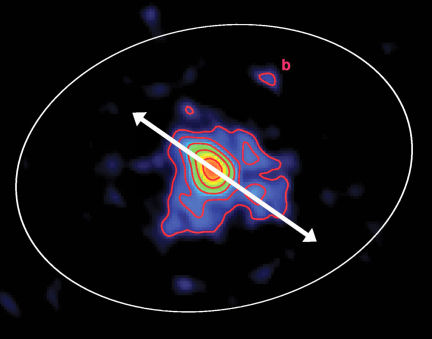Caught in the Act? Images may reveal planetary birth
They might be planets.

Peering into disks of gas and dust that surround young stars, two teams of astronomers have for the first time imaged dusty clumps that could be planets in the making.
Material within the disks, ubiquitous around newborn stars, can coalesce into planets. It’s uncertain whether the faint clumps seen in the new images are planets, heavier objects known as brown dwarfs, or just background objects that happen to lie in the same patch of sky.
The glare of starlight makes it difficult to study the faint light from disks. One team, led by Ben Oppenheimer of the American Museum of Natural History in New York City, used a U.S. Air Force telescope in Maui, Hawaii, to examine a disk surrounding the young star AB Aurigae, some 460 light-years from Earth. A telescope mask blocked the bright light from the parent star, and a polarizing filter further suppressed that light. Also, a mirror on the telescope rapidly flexed to remove the twinkling caused by Earth’s turbulent atmosphere.
Infrared images show a gap in the disk, along with what appears to be a barely discernible point of light at the center of this hole. The researchers suggest that the point represents a place where gas and dust has begun to gather into a small body—:either a planet or a brown dwarf—:and has cleared the area around it. “We may be witnessing such a process for the first time,” the astronomers will report in the June 10 Astrophysical Journal.
The body lies about 2.5 times farther from the star than Pluto’s average distance from the sun and is presumably the same age as AB Aurigae, a youthful 1 million to 3 million years old. It has a mass between 5 and 37 times that of Jupiter, Oppenheimer adds.
Another team, taking advantage of a rare chance to use the Very Large Array of radio telescopes near Socorro, N.M., in conjunction with another radio telescope 50 kilometers distant, examined the disk around the star HL Tau. The star, about 520 light-years from Earth, is only about 100,000 years old. Jane Greaves of the University of St Andrews in Scotland and her colleagues observed radio emissions that indicate the disk hosts pebble-sized rocks—:a clue that some material has begun to coalesce into planets.
Greaves also spied an enormous clump of gas and dust “which is exactly how a very young protoplanet should look,” she says. The clump has a diameter about five times the distance between Jupiter and the sun. “We are seeing [this object] at an incredibly early stage,” Greaves says.
The candidate protoplanet is about 14 times Jupiter’s mass and lies about twice as far from HL Tau as Neptune does from the sun, Greaves announced this week in Belfast at the Royal Astronomical Society National Astronomy Meeting.
Alan Boss of the Carnegie Institution of Washington (D.C.) says the two new discoveries are “equally exciting, equally promising, and equally dubious. The safest course of action right now is to call both of these clumps candidate protoplanets or candidate brown dwarfs.”
Next year, Greaves’ team plans to observe the protoplanet with an upgraded array of radio telescopes in the United Kingdom.







